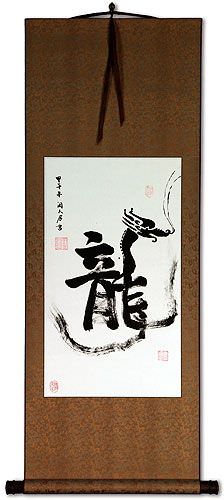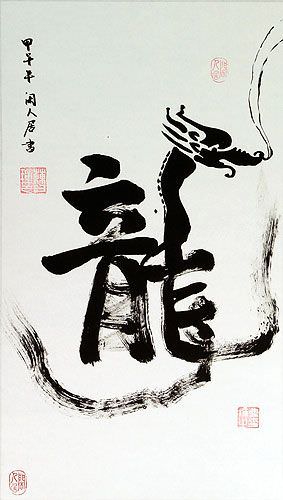
44¾"
20¼"

Approximate Measurements
Artwork Panel: 33cm x 58.3cm ≈ 13" x 23"
Silk/Brocade: 42.3cm x 113.8cm ≈ 16¾" x 44¾"
Width at Wooden Knobs: 51.3cm ≈ 20¼"

Close up view of the calligraphy artwork mounted to this silk brocade wall scroll
Chinese Symbol Wall Scroll
This Chinese character is "long" which means dragon. This one was drawn to look a bit like an actual dragon while being in the form of the character for dragon.
(Note: This "long" is not English, so the "o" vowel sound is more like "oh" in English)
In Chinese culture, the dragon represents power and for many generations, only the emperor could dare to wear the symbol of a dragon on their clothing.
If you hang this on your wall, it indicates that you are strong and powerful. A great gift for a corporate executive with a chip on his shoulder - lol.
This is probably the most popular Chinese character for tattoos these days. You'll see it on the shoulders of pro-basketball players, and on the hips of pop star divas. Of course, half of them have no idea what this symbol means, and the other half incorrectly think it directly means "warrior" or "power".
Of course, long before it became a tattoo staple, the mythological dragon roamed the earth - at least in the legends and minds of Asian people.
The history of the dragon is hidden deep in myth and history. Drawings and symbols of this mythological animal can be traced back to prehistoric tribal peoples of China. Evidence of the dragon's importance in Chinese culture can be traced to dragon figures and other artifacts unearthed from the Yin Dynasty (3000 years ago).
This was painted by a friend named Cao Zhang. He's a Buddhist calligrapher who currently lives in Lakeside, California with his wife, son, and daughter. His daughter and mine are schoolmates, and my wife can often be found at his special Buddhist meditation sessions.
This is painted on xuan paper (often incorrectly called "rice paper"). The raw artwork was then taken to my workshop in east Beijing where the master mounter built it into a handmade wall scroll.